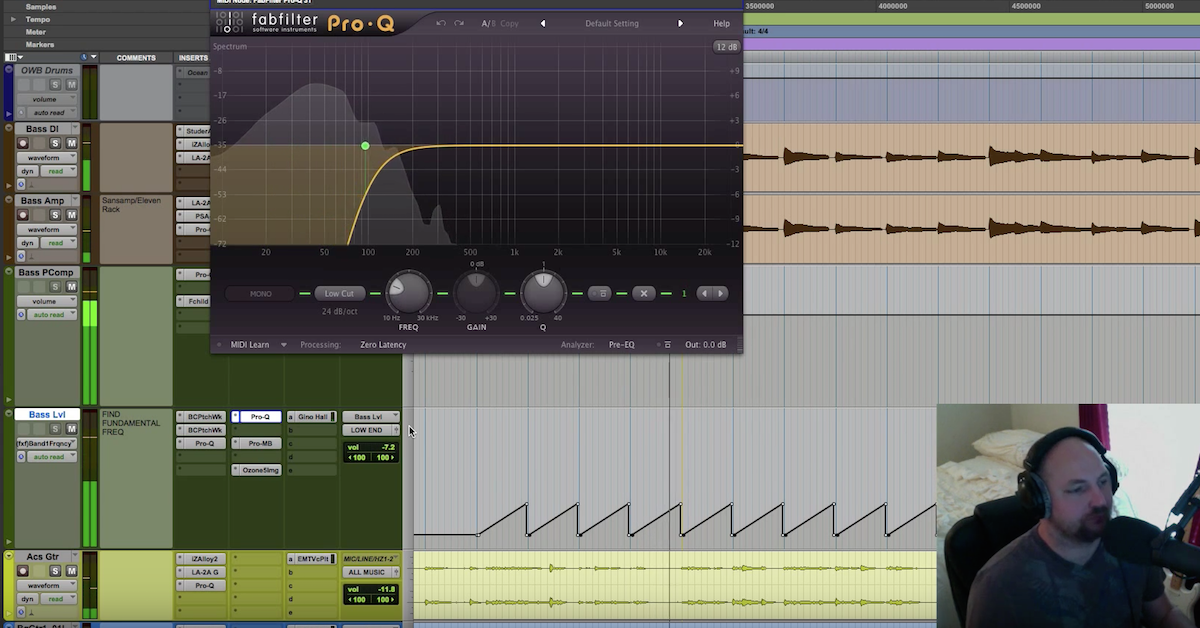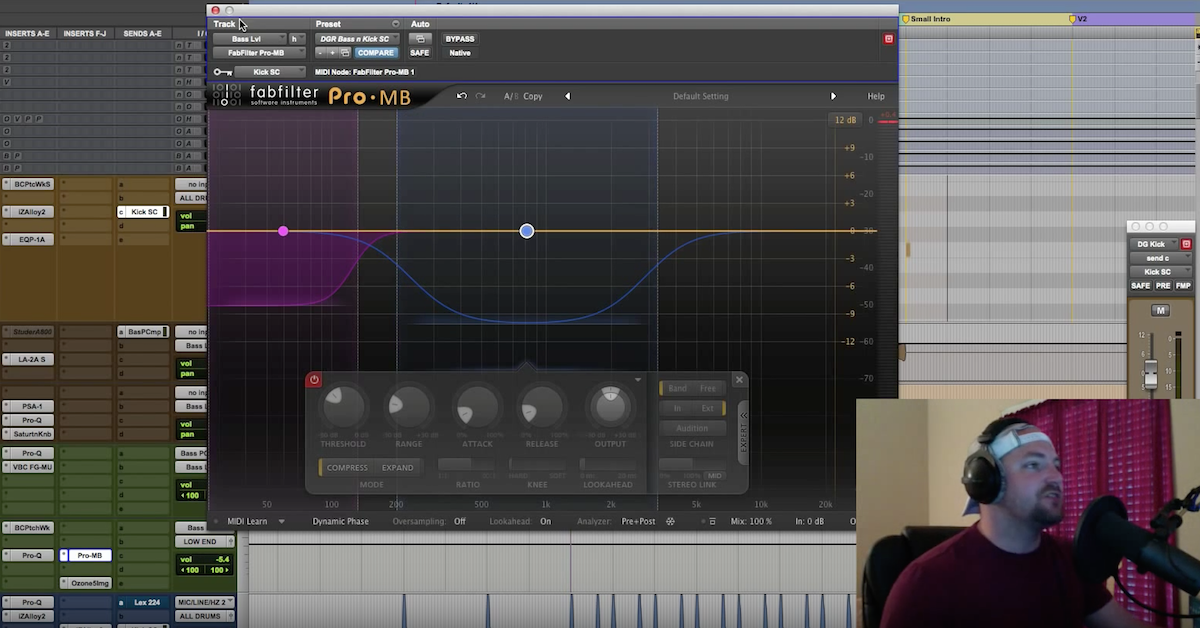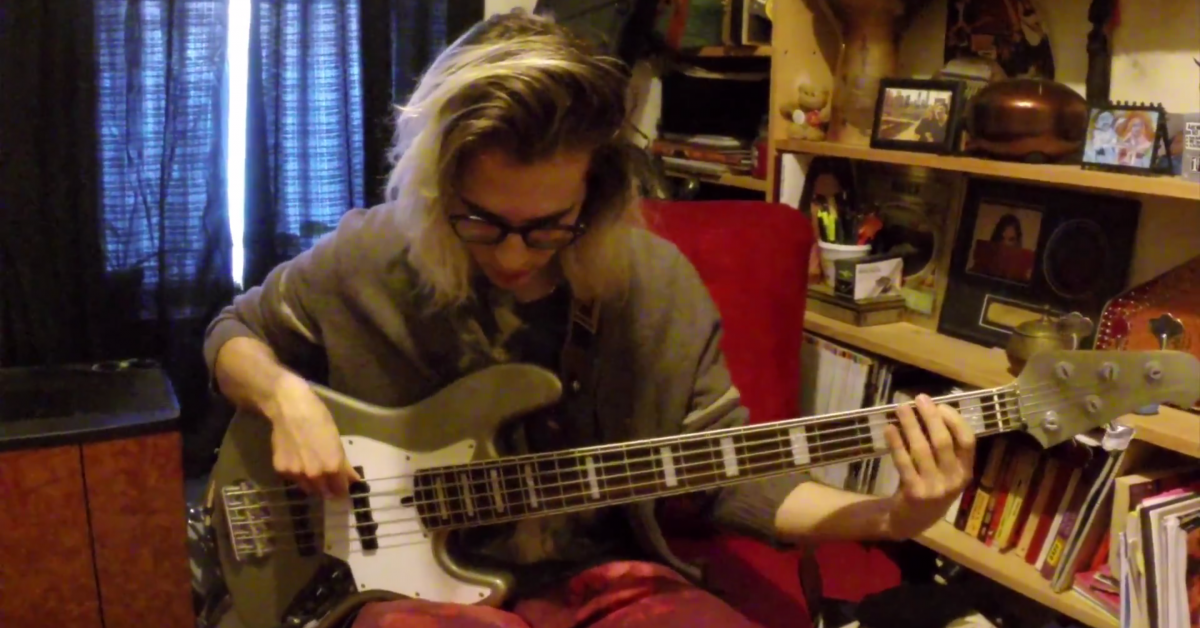5 Ways to EQ a Bass Guitar Without Using an EQ
I’m going to give some example of some thoughts I had earlier about using different fingers, or different materials, and foam to get sounds out of the bass.
I’m gonna start, I’m gonna show you with playing a low note and moving my picking hand from playing up on the neck, all the way back close to the bridge.
[bass guitar picking examples]
It’s almost like a synth sound, right?
It’s a very different vibe.
So one of the other variations we can do is we can play with what a lot of people call the hook. It’s James Jameson was known for doing this, where he played everything with one finger. It’s called the hook because he would just kind of work his finger at it. And how this affects the sound is that when you play with one finger, the notes become really really even.
[bass guitar with one finger]
So if I’m playing notes like this. Every note is pretty uniform, opposed to if I was using two different fingers to play it.
[bass guitar with two fingers]
Hear it rocking back and forth? So no matter what you do, the sounds are gonna be slightly different from each other. Which is appropriate for a lot of things. It’s something to consider if you’re not happy with the sound you’re getting.
One other option using fingers is playing with our thumb. Our thumb is gonna yield more of a pillowy kind of sound. So if we’re starting a note like this. Playing like this is a bit softer. More of a pillowy sound. A little less attack in it. One thing cool I like to do when playing with my thumb is I play really soft and then I’ll hit the bass really hard with a compressor like an LA-2A or something like that. And it just really gets this really deep — almost no attack kind of sound. Just sits underneath everything really nicely.
But the same principles apply to using a thumb, depending on where you’re playing
[bass guitar playing with thumb in different positions]
It changes the sound. Some other things to consider is using foam, which I mentioned before. And I just have a piece of foam that I cut out, I think it was inside an old microphone case or something — there’s a lot of different places you can find foam. Some people go to the 99 cent store and get one of the foam pads that you use to wash dishes with and then just cut a little section off. I like this because it’s a little grey and a little less flashy in my bass.
Now the reason people started doing this was to emulate the sustain of the upright bass because without it you hear the sustain, I’m just gonna use the high G string as an example.
[bass guitar sustain without foam under strings]
It’s still going. Still going and I just cut if off there. Gonna put this underneath and put it all the way back near the bridge, which is it’s least muted setting. And just play it, see if you can hear the difference at all.
[bass guitar sustain with foam under strings]
You can hear it tapering off a lot faster. Just reaches certain sections where it just starts dipping down. As you move the foam up, it’s going to deaden the strings even more. So this is it’s highest muted setting which is almost — it’s pretty much — it is actually touching the pickup.
That’s extreme, right?
[bass guitar with foam near pickups]
Because the strings are different diameters or different gauges, I find that they mute at different rates. So in order to deal with this, sometimes I shift the angle of the foam because ti takes less time for the high string to get muted than the low string. So, I do this so that I can get them both to be the same.
I like this. It’s kind of a very retro-y, very 60’s bass sound. But you can move it around and find where it works, it’s kind of just taps out the sustain a little bit. Probably better suited for retro sounds rather than modern sounds.
You can also use picks to play a bass. Right now I have a Gibson heavy pick here, and it’s got this — it’s kind of a bigger looking pick with three points on it. This is common for bass players. Now, a pick — as you hear from me playing — has a lot more attack to it. It’s almost a little bit more like a piano bass note. Just a lot of attack with a little bit of low end. And of course, wherever you move it — like with everything, it greatly affects the EQ. As does using different pick materials, which I’m looking for here. Actually, at my sessions I keep a giant pick container around, I just have all different kind of picks that are made from different materials. There are sizes — right now I’m just gonna use a regular Fender medium pick that most guitar players use.
[bass guitar with Fender medium pick]
Doesn’t quite have as much low end as the heavy pick. That may or may not be appropriate, depending on what you’re trying to create sound-wise. The last option I have is using a ceramic pick. You can get picks made out of all different crazy materials. There’s wood, and there’s — what else do they — there are different kinds of stone even. This is a ceramic and it has a very different sound to it.
[bass guitar with ceramic pick]
You can almost hear it hitting the string before the sound comes out. So there’s a percussive attack and then the pitched low note sound comes out. Which could be cool for some things.
I find it’s best to capture the sounds right at the source, closest to how they’re supposed to be in the end. This makes mixing so much easier — it’s less of a guessing game. And quite frankly there are just certain things that you can’t tweak. You can’t make a bass sound like you’re playing close to the bridge if the bassist wasn’t playing close to the bridge. So I really think it’s worthwhile to take the extra time while you’re in a production to understand the end result and not only how the performance is supposed to be played, but how it’s supposed to be captured. You’ll find that the greatest session musicians are used to this, and they’re very quick to adapt to a different technique.
Overview:
5 ways to EQ a bass guitar at the source without ever touching an actual EQ…
1. Playing a low note and moving the picking hand from playing up on the neck to closer to the bridge.
2. Playing with one finger aka “the hook” a la James Jameson.
3. Playing with your thumb to yield more of a pillowy kind of sound. Sometimes following that up with a lot of compression.
4. Using foam under the strings near the bridge to reduce the sustain, almost emulating the sustain of an upright bass. You can also tilt the foam so all the strings have a more uniform length of sustain.
5. Using different picks for different sounds and attack. You can change the sound by changing pick materials, size and more.





